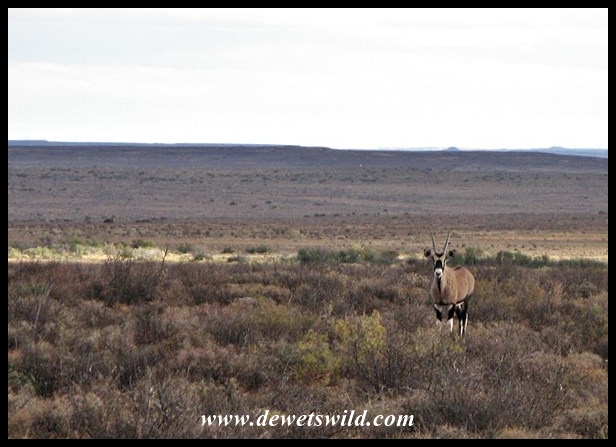Oryx gazella
The large and beautiful Gemsbok (also known as the Southern Oryx) is synonymous with South Africa’s arid Karoo and Kalahari regions. They occur under the harshest imaginable conditions in the Namib desert, but also in a wide range of more hospitable environments, such as open thornveld, mopane shrub and open grasslands, and are often encountered on rocky hillsides in these areas. Gemsbok are mixed feeders, consuming mostly short grass, leaves and shoots, roots and tubers, fruits and seedpods, showing specific preferences in each season. They are entirely independent of drinking water, but will drink up to 9 liters a day when it is available.

Gemsbok bulls can weigh up to 240kg and stand up to 1.3m high at the shoulder. Cows are slightly smaller in build, but usually have longer (and thinner) horns. For such large animals they are superbly adapted to a life in harsh, arid environments, being able to concentrate their urine and reabsorbing the maximum possible moisture from their dung. Gemsbok can even allow their body temperature to rise from a normal 36°C to 45°C before having to sweat and pant to cool down!
Gemsbok occur in herds consisting of cows, calves and non-breeding bulls that move over the territories of several dominant territorial breeding males. The mixed herds are normally quite small, numbering between 5 and 40 animals, but can at times form temporary aggregations of up to 300 strong in response to favourable localised conditions. Breeding herds can cover enormous home ranges, especially during times of drought. They are normally active in the early morning and late afternoon, and often throughout the night, resting up during the heat of the day in any available shade.
Gemsbok are brave and aggressive, and thus very dangerous, especially when wounded or cornered or when protecting their calves. Single calves are born away from the herd at the end of the dry season, and remain hidden for the first few weeks after birth. Mothers return to the calves twice daily for nursing until she introduces the calf to the herd at between 3 and 6 weeks of age. Adult Gemsbok are only attacked by lions and spotted hyenas, who are often killed in the process, but unattended calves are easy prey for most of Africa’s predators. Gemsbok have a natural life expectancy of up to 20 years.

Gemsbok occur in South Africa, Zimbabwe, Botswana and Namibia, with the IUCN estimating a total population of between 326,000 and 373,000 and recognising no major threats to their continued survival. South Africa’s biggest single population of Gemsbok occur in the Kgalagadi Transfrontier Park, but they can also be seen at Karoo, Mapungubwe, Marakele, Mokala and Mountain Zebra National Parks, several other game and nature reserves, and on many private farms, where they are a popular game ranching species. The Beisa Oryx (Oryx beisa) from East Africa is now considered a seperate species.



























































They are beautiful. I love the color pattern of their face. Have a great week!
Marianne
LikeLiked by 1 person
The pictures hardly does them justice, Marianne – in real life they are even more breathtaking!
A wonderful week to you as well!
LikeLiked by 1 person
Thank you! 🙂
LikeLiked by 1 person
Magnificent!
LikeLiked by 1 person
That they absolutely are, Dina!
LikeLike
Such magnificent animals, Dries. Their survival skills are impressive.
LikeLiked by 1 person
It’s astonishing that they can flourish under conditions that will kill most other ungulates within a day or two!
LikeLiked by 1 person
Weereens Pragtige foto’s en leersame inligting,Dries!
LikeLiked by 1 person
Baie dankie Dina. Jy het ook al n paar absoluut briljante fotos van gemsbokke gepost!
LikeLiked by 1 person
Gorgeous animals! Love their metallic coloured horns/antlers !! Do they use them for fighting at mating season?? If so …Ouch!! 🙂 T.
LikeLiked by 2 people
Those horns are formidable weapons, Teresa, used in self defense and during mating season – I’ve seen photos of lions that were skewered!
LikeLiked by 1 person
wholly cow!! Yikes!! T.
LikeLiked by 1 person
Sjoe dis mooi!
LikeLiked by 1 person
Hulle is pragtige diere, Tina. Is daar van hulle in Polokwane se wildtuintjie ook?
LikeLiked by 1 person
Ja maar net ‘n paar In die week se koerant is daar mense wat kla dat daar so min diere is. Ek was in die begin van die jaar laas daar.
LikeLiked by 1 person
Mens wonder partykeer of als wat in die koerant gepubliseer word altyd waar is, en of dit maar net mense se persepsies of die redakteur se agenda is?
LikeLiked by 1 person
Vandat hulle twee renosters gedood het het dinge agteruit gegaan … Mens weet ook nie hoeveel geld beskikbaar is. Jy is reg mens kan nie alles glo nie
LikeLike
I saw lots of these in Namibia last summer. I don’t know how they manage those long horns.
LikeLiked by 2 people
I’m sure you have some great photos of them, Rosemarie – the open landscape in Namibia would accentuate their long horns even more!
LikeLike
Vir my is dit die heel mooiste bok en ek vermoed hulle dink ook so, want hulle staan altyd so mooi reg vir ‘n kamera.
LikeLike
My favourite antelope by far Dries – those horns!!!
LikeLiked by 2 people
They are magnificent creatures, Maurice!
LikeLiked by 1 person
I love all the information you provide about the wonderful creatures in South Africa. So I am guessing the drought conditions you had did not effect them at all?
LikeLiked by 3 people
I’m so happy to hear that you enjoy our “episodes” on our wildlife, thanks Lois! I suppose if anything the drought may actually have benefitted the Gemsbok by forcing competing hetbivores to other areas.
LikeLiked by 2 people
Beautiful.
janet
LikeLiked by 2 people
They certainly are, Janet!
LikeLiked by 1 person